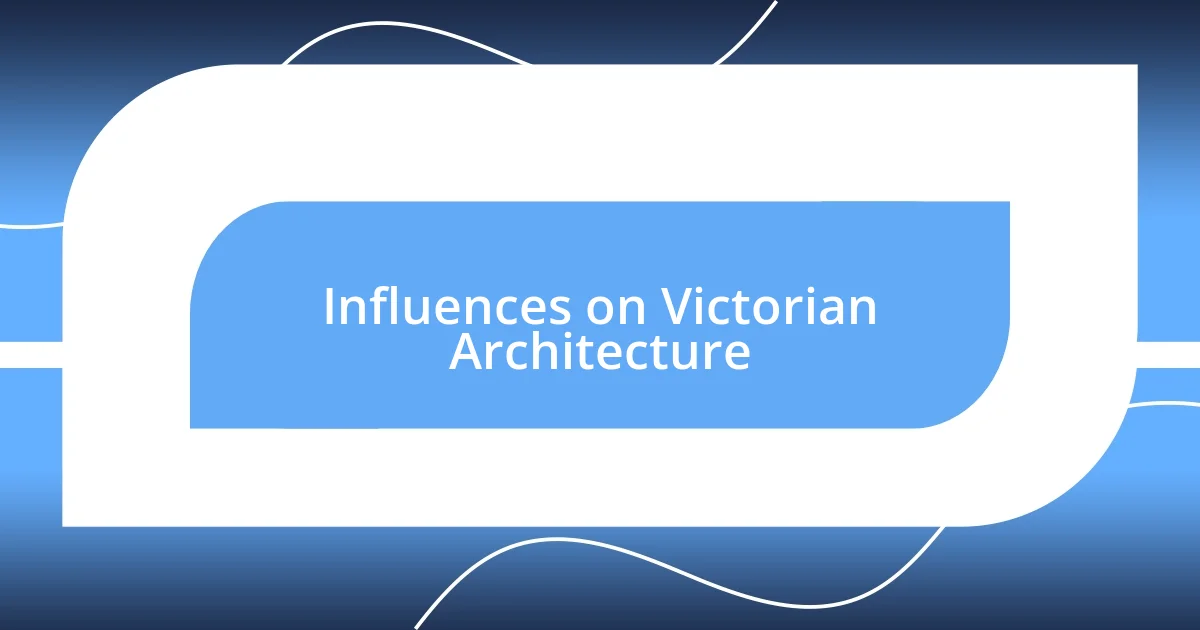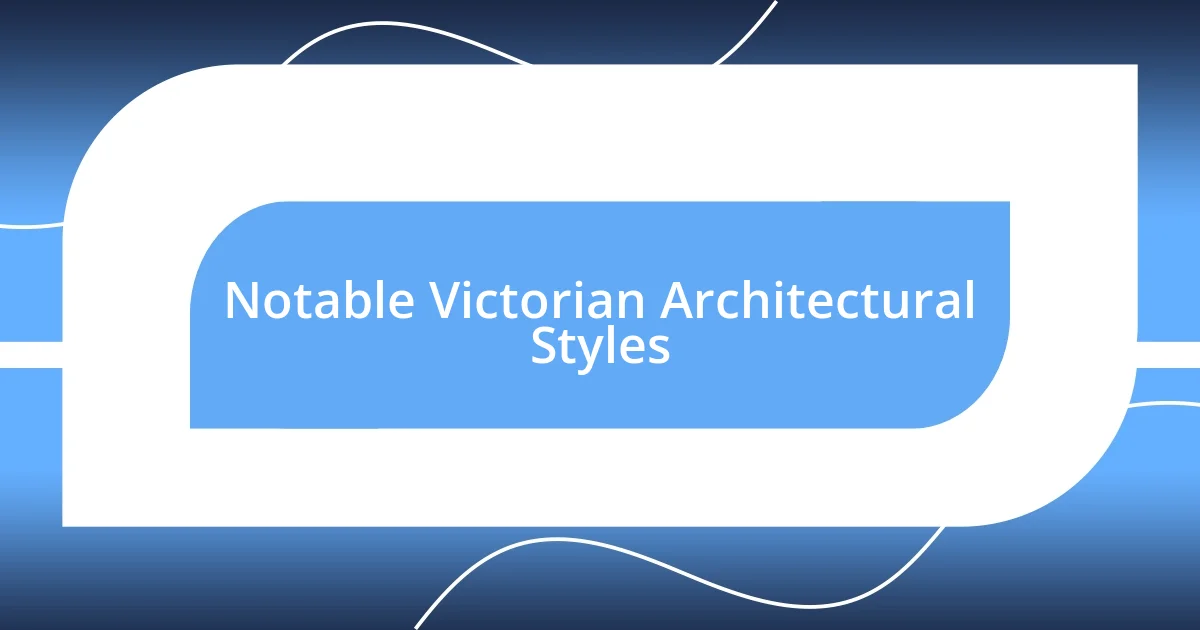Key takeaways:
- Victorian architecture showcases distinctive features like asymmetrical facades, vibrant colors, and intricate decorative details that reflect the era’s cultural values and societal shifts.
- Influences such as the Industrial Revolution and various historical revival movements shaped Victorian design, integrating advancements in materials and techniques to enhance aesthetic richness.
- Lessons from Victorian design emphasize embracing individuality, the importance of ornamentation, and balancing functionality with aesthetic appeal, which can inspire modern architectural practices.

Understanding Victorian Architecture
Victorian architecture often strikes me as both grand and intricate, reflecting the cultural shifts of the era. When I first wandered through a Victorian neighborhood, the elaborate detailing and vibrant colors made me feel like I’d stepped back in time. Have you ever noticed how even the smallest elements, like the banisters or window frames, often tell a story about the people who once lived there?
The key characteristics of Victorian architecture—such as asymmetrical facades, decorative trim, and varying rooflines—create a unique visual experience that is almost overwhelming in its beauty. I remember visiting a particularly stunning Victorian house and marveling at how each element seemed to communicate with the others. Isn’t it fascinating to think that these homes were designed to showcase both wealth and creativity?
Exploring Victorian architecture has taught me about the cultural values of the time, such as the rise of the middle class and the importance of individual expression. I often ponder what life was like for the families who inhabited these homes. How did they feel walking up those ornate steps, under the intricate cornices and stained glass? It’s these connections to history that make Victorian architecture so emotionally resonant for me.

Key Characteristics of Victorian Design
The distinct and eclectic nature of Victorian design stands out with remarkable features. For instance, the use of vibrant colors combined with intricate decorative details is something I always find enchanting. One day, while admiring a Victorian home adorned with ornate brackets and colorful shutters, I felt a sense of joy in the expressive creativity it represented.
Another compelling aspect is the asymmetrical layouts—these homes often appear to have grown organically rather than through strict design guidelines. I still remember the first time I entered a Victorian house with a sprawling porch wrapped around the front; I was struck by the charm and how it seemed to welcome everyone to gather. This invitation speaks volumes about the social fabric of that time.
Lastly, the use of patterned tiles, stained glass, and elaborate woodwork adds layers of interest. During a recent visit to a historical society, I learned more about how these details weren’t just aesthetics—they were a declaration of status. Every corner I turned revealed another layer of history, making me reflect on the stories held within these designs that have stood the test of time.
| Key Characteristics | Description |
|---|---|
| Asymmetrical Facades | Creates an organic, flowing appearance. |
| Decorative Trim | Intricate details that add richness and texture. |
| Vibrant Colors | Bold colors that express creativity and individuality. |
| Layered Textures | Incorporation of varied materials for depth. |
| Varied Rooflines | Unique silhouettes that capture the eye. |

Influences on Victorian Architecture
The influences on Victorian architecture truly reflect a fascinating confluence of different design philosophies and societal shifts. The Industrial Revolution played a pivotal role, as it provided not only new materials but also advanced techniques for construction. Walking through cities dotted with Victorian structures, I can almost feel the energy of the era—an ambitious population that sought to showcase their newfound wealth and creativity through elaborate designs.
Key influences on Victorian architecture include:
- Historical Revival Movements: Styles such as Gothic Revival and Italianate influenced the architecture of the time, imbuing buildings with romantic elements.
- Technological Advancements: Innovations like cast iron and glass facilitated more ornate designs, allowing for features like ornate railings and expansive windows.
- Cultural Influences: The fascination with nature during the Romantic movement brought about designs that integrated gardens and natural motifs, making the exterior as artistic as the interior.
- Social Movements: Changes in societal structure, primarily the rise of the middle class, encouraged a shift toward personalization in design, with more emphasis on unique and expressive structures.
I felt an overwhelming sense of appreciation for the intricacies involved when I visited a small museum dedicated to Victorian life. Studying blueprints and photographs of homes from the era, I noticed how even the tiniest details, like the window embellishments or door hardware, were meticulously designed. This level of care reminds me that every element was chosen to reflect not just function but a deeper personal narrative. We can easily overlook these layers, but they reveal a cultural tapestry rich with ambition and identity.

Notable Victorian Architectural Styles
One of the standout styles of Victorian architecture has to be the Gothic Revival. The towering spires and pointed arches instantly transport me to a world of romanticism and grand narratives. I remember wandering through a neighborhood where each home seemed like a castle, with elaborate facades that beckoned me to explore. It’s fascinating how this style draws inspiration from medieval structures, making you feel as if you’ve stepped back in time.
Then there’s the Italianate style, characterized by its wide eaves and ornate brackets. I distinctly recall visiting a city with stunning Italianate row houses that seemed to celebrate leisure with their inviting balconies and large windows. Each glance at these details made me ponder how they reflect an era that valued beauty and comfort in domestic spaces—what a wonderful way to express one’s lifestyle and aspirations!
Lastly, the Queen Anne style offers an eclectic mix of shapes and textures, often adorned with shingles and intricate woodwork. I have this vivid memory of attending a local Victorian house tour where every turn revealed a new surprise—a turret here, a sunroom there. It made me consider how these varied elements contribute to a home’s narrative, creating a visual dialogue that speaks volumes about its inhabitants’ personalities. Isn’t it incredible how architecture can embody such rich stories?

Famous Victorian Buildings to Visit
When it comes to iconic Victorian buildings, the Royal Albert Hall in London stands out as a must-visit architectural marvel. I remember stepping into the grand auditorium, overwhelmed by the sheer scale and beautiful mosaics that adorn its interior. The striking dome captures the essence of the Victorian spirit—ambitious, artistically rich, and unapologetically opulent. How does a space like this make you feel? For me, it was a mixture of awe and inspiration, a real testament to the era’s dedication to grandeur.
Another gem is the Hanging Gardens of Babylon-inspired a design, the Palace of Westminster, also known as the Houses of Parliament. I’ll never forget gazing up at its impressive Gothic façade, complete with the iconic Big Ben towering above. The intricate stonework and elaborate towers make it not just a seat of power but a visual feast. As I walked along the River Thames, I felt a deep connection to history, imagining all the important decisions made within those walls. Can you picture that kind of weighty significance resting upon the architecture?
Lastly, I highly recommend exploring the iconic Painted Ladies in San Francisco. Standing on Alamo Square, I watched as these Victorian homes, with their pastel colors and ornate detailing, danced with the sunlight. There’s something about their charm that made me reflect on how architecture can narrate and celebrate community. I remember taking countless photos, trying to capture their beauty, but how could that ever do justice to the stories they hold? Each facade seems to whisper the memories of families who once lived there—what a delightful thought that is!

Lessons from Victorian Design Principles
The Victorian design principles teach us to embrace variety and eccentricity. I once visited a Victorian block and was immediately struck by how each house had its unique flair, from bold color choices to differing rooflines. It made me realize that celebrating individuality in architectural design can foster a sense of community and character, inviting each homeowner to contribute their unique narrative to the neighborhood.
One lesson that resonates with me is the importance of ornamentation in Victorian architecture. I remember walking through a beautifully preserved Victorian district where every doorframe and window was a work of art. The intricate details ignited my imagination, leading me to think about how thoughtful embellishments can turn a mundane structure into something truly captivating. Isn’t it fascinating how a touch of creativity can transform the ordinary into the extraordinary?
Victorian architecture also emphasizes the balance between functionality and aesthetic appeal. I had the chance to explore a Victorian home with large, airy rooms that were both practical and delightful to inhabit. This balance reminded me that homes should not only serve a functional purpose but also bring joy and beauty to our daily lives. It begs the question: How can we integrate elements of this philosophy into modern design to enhance our living spaces?

Applying Victorian Aesthetics Today
Incorporating Victorian aesthetics into today’s design might feel daunting, but I believe it’s all about embracing that same sense of character and individuality. I recently attended a home design expo where several booths highlighted bold, vibrant color palettes inspired by Victorian tones. Walking through those displays, I could almost hear the walls speak—full of personality and delight. Have you ever considered how a splash of color can invigorate a room? It’s truly transformative.
The art of layering textures, another hallmark of Victorian style, can be a game-changer in modern interiors. I often find myself inspired by how fabrics and materials converge to create warmth and depth. At a friend’s house, we rearranged her living room with vintage textiles, chunky knits, and plush cushions, effortlessly echoing the Victorian passion for comfort and opulence. It made me reflect on how inviting a space can resonate with a deeper emotional connection. What elements can we introduce to make our homes feel cozier and more lived-in?
Finally, let’s talk about architectural details—those exquisite touches that bring any space to life. I once walked into an office that seamlessly integrated intricate moldings and vintage fixtures into a contemporary setting. It struck me as the perfect marriage between eras, where history whispers its charm amidst modern convenience. Have you ever noticed how such details can evoke nostalgia while still feeling fresh? It’s a potent reminder that even the smallest accents can tell powerful stories and enrich our daily experiences.














